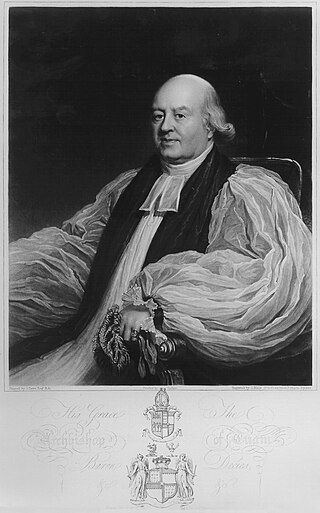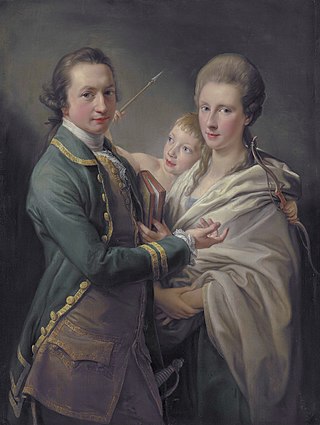Related Research Articles

Earl of Kingston is a title in the Peerage of Ireland. It was created in 1768 for Edward King, 1st Viscount Kingston. The Earl holds the subsidiary titles Baron Kingston, of Rockingham in the County of Roscommon, Viscount Kingston, of Kingsborough in the County of Sligo, Baron Erris, of Boyle in the County of Roscommon, and Viscount Lorton, of Boyle in the County of Roscommon, also in the Peerage of Ireland. He is also a baronet in the Baronetage of Ireland. Between 1821 and 1869 the earls also held the title Baron Kingston, of Mitchelstown in the County of Cork, in the Peerage of the United Kingdom.
Baron Crofton is a title in the Peerage of Ireland. It was created in 1797 for Dame Anne Crofton. She was the widow of Sir Edward Crofton, 2nd Baronet, of the Mote, who had represented Roscommon in the Irish House of Commons and had been offered a peerage just before his death. The peerage was instead bestowed upon his widow. She was succeeded by her grandson, the second Baron, who had already succeeded as fourth Baronet. He sat in the House of Lords as an Irish Representative Peer from 1840 to 1869 and served as a Lord-in-waiting in the three Conservative administrations of the Earl of Derby and in Benjamin Disraeli's first government. His son, the third Baron, served as an Irish Representative Peer between 1873 and 1912 and was also State Steward to the Lord Lieutenant of Ireland. His nephew, the fourth Baron, was an Irish Representative Peer from 1916 to 1942. As of 2014 the titles are held by the latter's great-great-grandson, the eighth Baron, who succeeded his father in 2007.
Baron Athlumney, of Somerville and Dollarstown in the County of Meath, was a title in the Peerage of Ireland. It was created in 1863 for the Liberal politician Sir William Meredyth Somerville, 5th Baronet, who had previously served as Chief Secretary for Ireland. In 1866 he was also created Baron Meredyth, of Dollardstown in the County of Meath, in the Peerage of the United Kingdom. He was succeeded by his eldest and only surviving son from his second marriage, the second Baron. He was childless and on his death in 1929 the baronies became extinct while the baronetcy became dormant.

George de la Poer Beresford, 1st Marquess of Waterford, KP, PC (Ire) was an Anglo-Irish politician, known as George Beresford, 2nd Earl of Tyrone from 1763 to 1789.
William Annesley, 1st Viscount Glerawly was an Irish politician and noble.

William Beresford, 1st Baron Decies was an Anglo-Irish clergyman.

Arthur Saunders Gore, 2nd Earl of Arran, KP, PC (Ire), styled The Honourable Arthur Gore from 1758 to 1762 and Viscount Sudley from 1762 to 1773, was an Irish peer and politician.
Sir Edward Crofton, 2nd Baronet was an Irish politician.

Sir Andrew Agnew, 8th Baronet DL was a Scottish politician and baronet.
Sir Tristram Beresford, 3rd Baronet was an Anglo-Irish soldier, politician and baronet.

Marcus Beresford, 1st Earl of Tyrone, known as Sir Marcus Beresford, 4th Baronet, until 1720 and subsequently as The Viscount Tyrone until 1746, was an Anglo-Irish peer and politician.
Gorges Lowther was an Irish Member of Parliament.
Peter Metge was an Irish politician and judge of the eighteenth and early nineteenth centuries. He was a colourful character, who was noted for his fondness for duelling, and for his unorthodox private life.
The Crofton Family is an Anglo-Irish noble family holding titles in the Peerage of Ireland and The Baronetage of the United Kingdom.
Sir Edward Crofton, 2nd Baronet was an Irish landowner and politician, who sat in the Irish House of Commons for more than thirty years, and served briefly as a member of the Privy Council of Ireland.
Sir Edward Crofton, 3rd Baronet was an Anglo-Irish politician.
Sir Edward Crofton, 4th Baronet was an Anglo-Irish politician.
Sir Edward Crofton, 1st Baronet (1624–1675) was an Anglo-Irish Royalist politician.
Sir Marcus Somerville, 4th Baronet was an Anglo-Irish politician.
The Crofton Baronetcy, of The Mote in County Roscommon, was created in the Baronetage of Ireland on 1 July 1661 for Edward Crofton, as a reward for his record of loyalty to King Charles II during the English Civil War. He sat in the Irish House of Commons as member for Lanesborough, and served as High Sheriff of Roscommon and High Sheriff of Leitrim. He was succeeded in the title by his son Edward, the second Baronet, who sat in the Irish House of Commons as member first for Boyle, and subsequently for Roscommon, and was a member of the Privy Council of Ireland in 1713–14. He was a prominent opponent of King James II of England, and was attainted by the Patriot Parliament of 1689, but recovered his estates the following year. His eldest son, the third baronet, also represented Roscommon in the House of Commons. The title became extinct on the death of the fifth Baronet in 1780.
References
- 1 2 3 4 5 Cokayne, George Edward (1900). Complete Baronetage (Volume V). Exeter: W. Pollard & co., ltd. p. 360.
- ↑ E. M. Johnston-Liik, MPs in Dublin: Companion to History of the Irish Parliament, 1692–1800 (Ulster Historical Foundation, 2006), p.103 (Retrieved 31 March 2020).